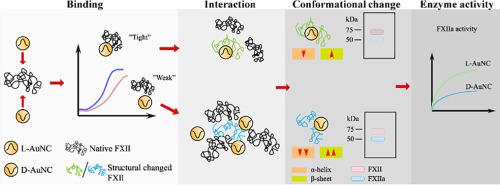NanoImpact ( IF 4.7 ) Pub Date : 2021-05-07 , DOI: 10.1016/j.impact.2021.100321 Fang Hao 1 , Fanglan Geng 2 , Xingchen Zhao 2 , Rui Liu 2 , Qian S Liu 2 , Qunfang Zhou 3 , Guibin Jiang 4

|
Probing the interaction of nanomaterials (NMs) with proteins is the basic step for biological safety assessment. Many physiochemical factors of NMs play important roles in binding with proteins as they determine the binding process. Among them, the chirality-related biological effects and nanotoxicology have not been fully understood. As NMs are mainly exposed to human circulatory system with intentional or unintentional exposure, understanding the interaction mechanism of plasma functional proteins with chiral NMs is of great importance. Herein, we show the interaction of chiral gold nanoclusters (AuNCs), L- and D-cysteine coated AuNC (i.e., L-AuNC and D-AuNC, respectively) with human coagulation factor XII (FXII, an important plasma zymogen initiating the inner coagulation system). D-AuNC exhibited weak binding affinity for FXII, induced FXII aggregation due to significant conformational change, which then activated the FXII for further cleavage. In contrast to D-AuNC, the binding affinity of L-AuNC for FXII was strong and their bioconjugate was quite stable without aggregation. L-AuNC induced the structural change and autoactivation of FXII to a lower extent. Moreover, the enzymatic activity of FXIIa (the activated form of FXII) was influenced upon incubation with L- AuNCs and D-AuNCs with different molecular mechanisms. The finding will expand the understanding of the nanobiological effects of chiral NMs and suggest the potential application in nanomedicine.
中文翻译:

金纳米团簇的手性影响其与凝血因子 XII 的相互作用
探索纳米材料(NMs)与蛋白质的相互作用是生物安全性评估的基本步骤。NMs 的许多理化因子在与蛋白质结合中发挥重要作用,因为它们决定了结合过程。其中,手性相关的生物学效应和纳米毒理学尚未完全了解。由于 NMs 主要以有意或无意的方式暴露于人体循环系统,因此了解血浆功能蛋白与手性 NMs 的相互作用机制非常重要。在此,我们展示了手性金纳米团簇 (AuNCs)、L-和 D-半胱氨酸包被的 AuNC(即,L-AuNC 和 D-AuNC,分别)与人凝血因子 XII(FXII,一种重要的血浆酶原启动内部凝血系统)。D-AuNC 对 FXII 表现出较弱的结合亲和力,由于显着的构象变化诱导 FXII 聚集,然后激活 FXII 进行进一步切割。与 D-AuNC 相比,L-AuNC 对 FXII 的结合亲和力很强,并且它们的生物偶联物非常稳定,没有聚集。L-AuNC在较低程度上诱导了FXII的结构变化和自激活。此外,FXIIa(FXII 的活化形式)的酶活性受到具有不同分子机制的 L-AuNC 和 D-AuNC 孵育的影响。这一发现将扩大对手性纳米材料的纳米生物学效应的理解,并提出在纳米医学中的潜在应用。











































 京公网安备 11010802027423号
京公网安备 11010802027423号